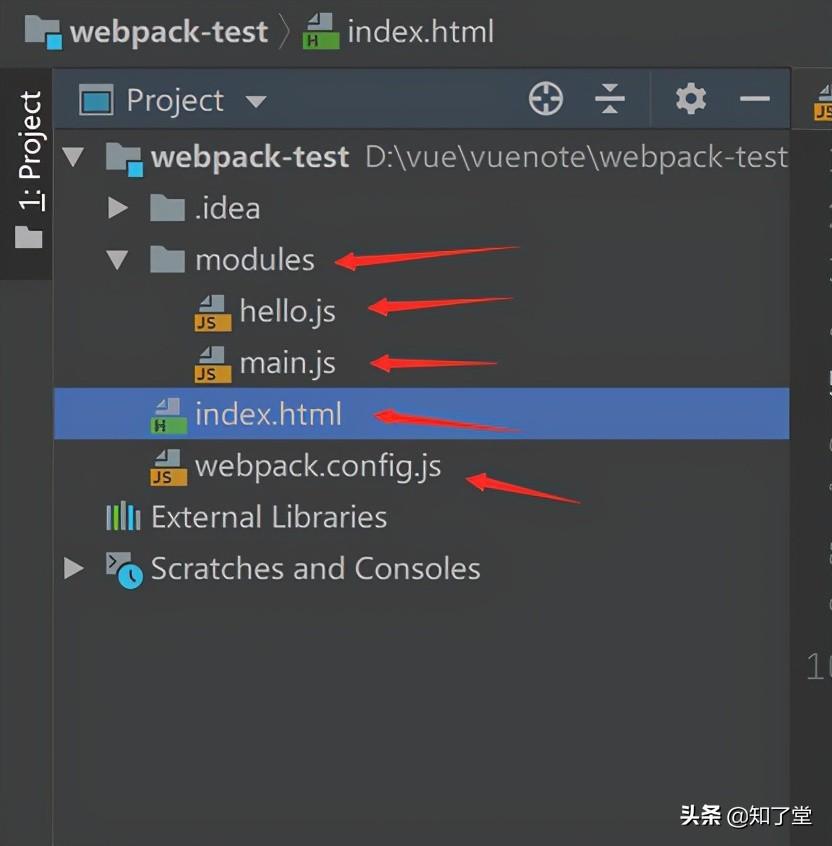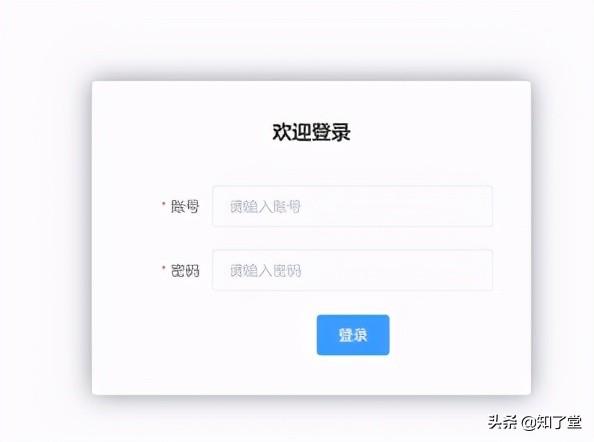vue-cli是官方提供的一个脚手架,用于快速生成一vue项目,有点类似java中使用maven构建项目
需要环境
Node.js : http://nodejs.cn/download/ 安装完后在Windows的cmd窗口输入 node -v及npm -v 如果有版本号,那么说明安装成功 也可以安装淘宝的镜像,这样下载的话会快很多,安装淘宝镜像后可以使用cnpm指令
# -g 全局安装npm install cnpm -gnpm config set registry https://registry.npm.taobao.orgnpm install cnpm -g安装位置:C:\Users\Administrator\AppData\Roaming\npm
安装vue-cli
#在命令台输入cnpm install vue-cli -g#查看是否安装成功vue list创建第一个vue-cli程序
1、在本地磁盘创建一个空文件夹用来存放项目 D:\vue\vuenote 2、使用控制台在该目录下执行创建vue应用程序指令
D:\vue\vuenote>vue init webpack first-vue
3、一路选择no 4、进入项目目录,安装依赖
D:\vue\vuenote>cd first-vueD:\vue\vuenote\first-vue>cnpm install5、启动项目
npm run dev打开浏览器输入 http://localhost:8080/

webpack
webpack是一个现代JavaScript应用程序的静态模块打包器(module bundler)。当webpack处理应用程序时,它会递归地构建一个依赖关系图(dependency graph),其中包含应用程序需要的每个模块,然后将所有这些模块打包成一个或多个bundle.
webpack的使用
1、在本地磁盘上创建一个空目录,并使用idea打开
2、按如下结构创建目录和文件

3、在hello.js暴露一个sayhai的方法
exports.sayHai=function () { document.write("<h1>hello world</h1>")}4、在main.js导入该方法
var hello=require('./hello')hello.sayHai()5、在webpack.config.js中配置打包
module.exports={ entry:'./modules/main.js', output:{ filename:'./js/bundle.js' }}6、在idea控制台运行 webpack指令 运行webpack指令后,会在当前项目的生成dist/js/bundle.js 7、在index.html中引入bundle.js文件
<!DOCTYPE html><html lang="en"><head> <meta charset="UTF-8"> <title>Title</title></head><body> <script src="dist/js/bundle.js"></script></body></html>Vue-Router路由
Vue Router是Vue.js官方的路由管理器(路径跳转)。它和Vue.js的核心深度集成,让构建单页面应用变得易如反掌。
安装路由
使用idea在当前项目的控制台上输入指令
cnpm install vue-router --save-dev路由的使用
1、在component目录下创建一个vue组件Content.vue
import Vue from 'vue'import VueRouter from 'vue-router'import Content from "../components/Content";//安装路由Vue.use(VueRouter);export default new VueRouter({ routes: [ { //路由路径 path: '/content', name: 'content', //跳转的组件 component: Content } ]})2、在当前项目下创建router目录,router目录下创建用来配置路由的配置文件index.js index.js内容如下:
import Vue from 'vue'import VueRouter from 'vue-router'import Content from "../components/Content";//安装路由Vue.use(VueRouter);export default new VueRouter({ routes: [ { //路由路径 path: '/content', name: 'content', //跳转的组件 component: Content } ]})3、在App.vue中配置请求路由
<template> <div id="app"> <img src="./assets/logo.png"> //请求路由 <router-link to="/content">内容页</router-link> //路由结果在此处展示 <router-view></router-view> </div></template><script>export default { name: 'App', components: { }}</script><style>#app { font-family: 'Avenir', Helvetica, Arial, sans-serif; -webkit-font-smoothing: antialiased; -moz-osx-font-smoothing: grayscale; text-align: center; color: #2c3e50; margin-top: 60px;}</style>vue+elementUI
vue配合elementUI可以使我们的页面更加美观
elementUI的使用
1、创建一个新的vue项目
vue init webpack vue_element2、安装插件(vue-router、element-ui、sass-loader、node-sass)
# 进入工程目录cd vue_element# 安装 vue-routernpm install vue-router --save-dev# 安装 element-uinpm i element-ui -S# 安装依赖npm install# 安装 SASS 加载器cnpm install sass-loader node-sass --save-dev# 启动测试npm run dev3、创建一个Login.vue组件,内容如下:
<template> <div> <el-form ref="loginForm" :model="form" :rules="rules" label-width="80px" class="login-box"> <h3 class="login-title">欢迎登录</h3> <el-form-item label="账号" prop="username"> <el-input type="text" placeholder="请输入账号" v-model="form.username"/> </el-form-item> <el-form-item label="密码" prop="password"> <el-input type="password" placeholder="请输入密码" v-model="form.password"/> </el-form-item> <el-form-item> <el-button type="primary" v-on:click="onSubmit('loginForm')">登录</el-button> </el-form-item> </el-form> <el-dialog title="温馨提示" :visible.sync="dialogVisible" width="30%" :before-close="handleClose"> <span>请输入账号和密码</span> <span slot="footer" class="dialog-footer"> <el-button type="primary" @click="dialogVisible = false">确 定</el-button> </span> </el-dialog> </div></template><script> export default { name: "Login", data() { return { form: { username: '', password: '' }, // 表单验证,需要在 el-form-item 元素中增加 prop 属性 rules: { username: [ {required: true, message: '账号不可为空', trigger: 'blur'} ], password: [ {required: true, message: '密码不可为空', trigger: 'blur'} ] }, // 对话框显示和隐藏 dialogVisible: false } }, methods: { onSubmit(formName) { // 为表单绑定验证功能 this.$refs[formName].validate((valid) => { if (valid) { // 使用 vue-router 路由到指定页面,该方式称之为编程式导航 this.$router.push("/main"); } else { this.dialogVisible = true; return false; } }); } } }</script><style lang="scss" scoped> .login-box { border: 1px solid #DCDFE6; width: 350px; margin: 180px auto; padding: 35px 35px 15px 35px; border-radius: 5px; -webkit-border-radius: 5px; -moz-border-radius: 5px; box-shadow: 0 0 25px #909399; } .login-title { text-align: center; margin: 0 auto 40px auto; color: #303133; }</style>4、配置路由
import Vue from 'vue'import VueRouter from 'vue-router'import Login from "../components/Login";//安装路由Vue.use(VueRouter)export default new VueRouter({ routes:[ { path:'/login', name:'login', component:Login } ]})5、在main.js引入路由和elementUI
// The Vue build version to load with the `import` command// (runtime-only or standalone) has been set in webpack.base.conf with an alias.import Vue from 'vue'import App from './App'import router from './router'//导入elementUIimport ElementUI from "element-ui"//导入element cssimport 'element-ui/lib/theme-chalk/index.css'Vue.config.productionTip = falseVue.use(router);Vue.use(ElementUI)/* eslint-disable no-new */new Vue({ el: '#app', router, render: h => h(App),//ElementUI规定这样使用})6、在App.vue中请求路由
<template> <div id="app"> <router-link to="/login">登录</router-link> <router-view></router-view> </div></template><script>export default { name: 'App', components: { }}</script><style>#app { font-family: 'Avenir', Helvetica, Arial, sans-serif; -webkit-font-smoothing: antialiased; -moz-osx-font-smoothing: grayscale; text-align: center; color: #2c3e50; margin-top: 60px;}</style>7、测试 npm run dev

注意:如果项目运行失败,可以在package.json里降低sass-loader和node-sass的版本
"sass-loader": "^7.3.1","node-sass": "^4.9.0",嵌套路由
简单说就是在路由里再套一个子路由
1、创建一个作为子路由Profile.vue组件
<template> <h1>用户列表</h1></template><script> export default { name: "List" }</script><style scoped></style>2、Main.vue里请求路由
<template> <div> <el-container> <el-aside width="200px"> <el-menu :default-openeds="['1']"> <el-submenu index="1"> <template slot="title"><i class="el-icon-caret-right"></i>用户管理</template> <el-menu-item-group> <el-menu-item index="1-1"> <!--插入的地方--> <router-link to="/user/profile">个人信息</router-link> </el-menu-item> <el-menu-item index="1-2"> <!--插入的地方--> <router-link to="/user/list">用户列表</router-link> </el-menu-item> </el-menu-item-group> </el-submenu> <el-submenu index="2"> <template slot="title"><i class="el-icon-caret-right"></i>内容管理</template> <el-menu-item-group> <el-menu-item index="2-1">分类管理</el-menu-item> <el-menu-item index="2-2">内容列表</el-menu-item> </el-menu-item-group> </el-submenu> </el-menu> </el-aside> <el-container> <el-header style="text-align: right; font-size: 12px"> <el-dropdown> <i class="el-icon-setting" style="margin-right: 15px"></i> <el-dropdown-menu slot="dropdown"> <el-dropdown-item>个人信息</el-dropdown-item> <el-dropdown-item>退出登录</el-dropdown-item> </el-dropdown-menu> </el-dropdown> </el-header> <el-main> <!--在这里展示视图--> <router-view /> </el-main> </el-container> </el-container> </div></template><script> export default { name: "Main" }</script><style scoped lang="scss"> .el-header { background-color: #B3C0D1; color: #333; line-height: 60px; } .el-aside { color: #333; }</style>3、测试

参数传递
参数传递过程:url请求路径—->路由接收参数—->跳转套组件显示参数
1、url请求路径
<router-link :to="{name:'Profile',params:{id:1} }">个人信息</router-link>2、路由接收参数
方式一:
{path:'/user/profile/:id',name:'Profile',component:Profile},方式二:
{path:'/user/profile/:id',name:'Profile',component:Profile,props:true}3、组件模板展示参数
方式一:
{ {$route.params.id} }方式二:
<template> <div> { {id} } </div></template><script> export default { //接收路由传过来的id props:['id'], name: "Profile" }</script><style scoped></style>路由钩子与异步请求
路由模式
hash:路径带 # 符号(默认),如 http://localhost/#/login history:路径不带 # 符号,如 http://localhost/login
路由钩子与异步请求
beforeRouteEnter:在进入路由前执行 beforeRouteLeave:在离开路由前执行 类似于过滤器,在进入模板前可以使用路由钩子进行异步请求数据,并在模板展示
<template> <div> { {info.url} } </div></template><script> export default { props:['id'], name: "Profile", beforeRouteEnter:(to,from,next)=>{ console.log("进入页面之前"); next(vm=>{ //进入路由之前执行getData方法 vm.getData() }); }, beforeRouteLeave:(to,from,next)=>{ console.log("离开页面之前") next(); }, //返回请求的数据 data(){ return{ info:{ } } }, methods:{ getData:function () { //使用axios异步请求数据 this.axios({ method:'get', url:'http://localhost:8080/static/mock/data.json' }).then(res=>(this.info=res.data)) } } }</script><style scoped></style> 鲁公网安备37020202000738号
鲁公网安备37020202000738号